Compiled by Geoff Goodall
Five former RAAF Mosquito fighter bombers were to later become civil registered
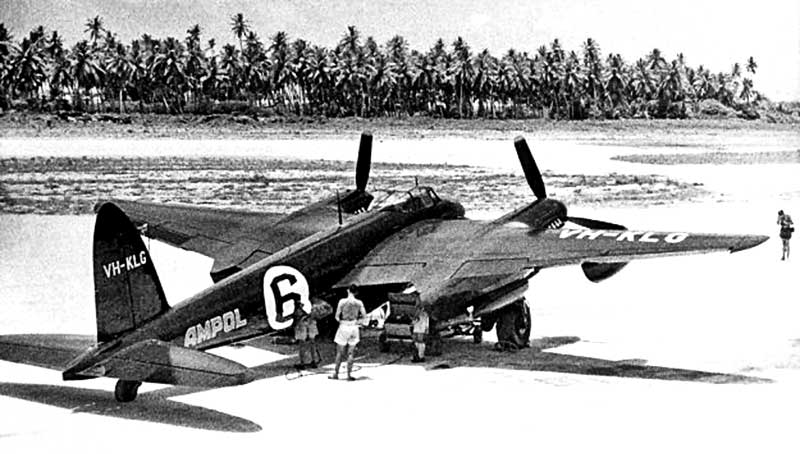
London-Christchurch Air Race. It was wrecked in a forced landing in Burma later that day. Photo: Max Mead
After the war, RAAF Mosquitos were used for aerial photographic mapping across Australia, New Guinea and Fiji by RAAF Survey Squadron which was later reformed as No. 87 (PR) Squadron. These final RAAF Mosquitos were retired during 1953 and the squadron was disbanded in December 1953. During 1954 well-maintained RAAF Mosquitos were listed for disposal by sealed-bid auction by the Department of Supply.
However two other Australian pilots were serious contenders, each basing his bid on acquiring a former RAAF Mosquito
In Perth, 60 year old Captain James "Jimmy" Woods, was a West Australian legend. He was a World War I flier who became chief pilot of the pioneering West Australian Airways and later MacRobertson-Miller Aviation. By 1953 he was operating his own company Woods Airways, flying Avro Ansons between Perth and Rottnest Island - often as a one-man operation which included driving the airline bus between Perth city and airport. By 1953 Woods had logged over 25,000 flying hours. Known as "Woodsy", his genial Scottish manner and newspaper reports of his regular stubborn disputes with DCA had won him strong public support.
Woods was no stranger to international flying, having flown his DH.60 Moth VH-UPD Spirit of Western Australia from Perth to London in 1933, and the following year he flew Lockheed Vega G-ABGK in the Centenary Air Race from London to Melbourne with navigator Donald Bennett. The Vega overturned during landing at Aleppo, Syria, forcing their withdrawal.
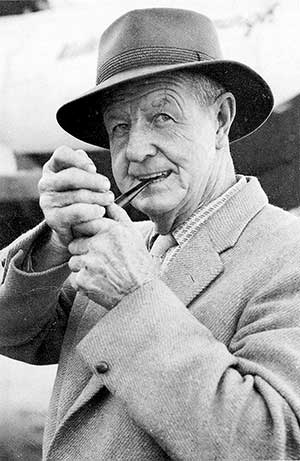 | 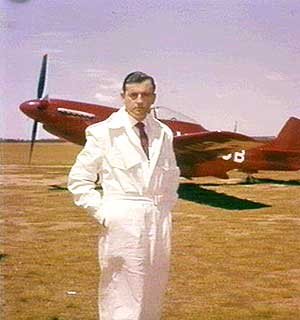 |
Aubrey Oates lobbied senior Federal politicians to allow a retired RAAF Mosquito to be released to allow him to make a patriotic Australian entry in the air race. The Minister for Air, William McMahon, was persuaded and in September 1952 instructed the Department of Supply to make a free issue of a servicable Mosquito. PR.41 A52-320 in storage at RAAF Amberley Qld was issued to Oates on 12.10.52. However for reasons unknown it was found to be unsuitable and approval was given to exchange it for another PR.41 stored at Amberley A52-324 which was issued to Oates on 6.11.52. His entry was sponsored by KLG Spark Plugs and Ampol Oil.
By early 1953 the Jimmy Woods entry had gained the sponsorship of The West Australian Newspaper in Perth. Woods personally aproached the Minister for Territories Paul Hasluck to make representations in Canberra on his behalf for a similar deal to that afforded Oates. In March 1953 McMahon agreed to the sale of a PR.41 to Woods but added a nominal price of £100. The sales contract stipulated that all further costs of preparing and ferrying the aircraft were the responsibility of the new owner.
| Built at Bankstown Aerodrome, Sydney by De Havilland Aircraft Pty Ltd. Built to RAAF order as a Mosquito FB Mk.40 A52-62 | |
| .48 | Production
delays and changing RAAF requirements resulted in this airframe being
modified on the assembly line and completed as c/n 3006 as a PR. Mk.41 A52-324 |
| 7.5.48 | Taken on RAAF charge as PR.Mk.41 A52-324. Recieved 2AD Richmond ex De Havilland Aircraft |
| 28.5.48 | Received 3AD Amberley ex 2AD. Held in storage under cover |
| 10.52 | Free issue ex 3AD to Mr. A. J. R. Oates, Sydney |
| 10.52 | Oates
and RAAF Flt Lt Douglas Swain, who had agreed to be his
copilot/navigator for the air race, were checked out on the aircraft at
Amberley by 3AD Test Pilot Max Garroway |
| 11.10.52 | Ferried from Amberley to Sydney by Oates and Swain |
| Painted in Sydney all red with registration in white, AMPOL emblem on
fuselage and under the port wing, and race number 6 on the fuselage
side. Standard RAAF long range fuel tanks were fitted under each wing | |
| 23.9.53 | Registered VH-KLG Aubrey J. R. Oates, Sydney NSW |
| DCA
would not consider civil type certification for an ex-military
Mosquito, but reluctantly agreed to allow VH-KLG to operate on a
Provisional CofA basis for the flight to London and air race | |
| Delays in
preparation resulted in Oates to leave Sydney with barely a week to
reach London in time for the Air Race Start from London Airport on 8
October 1953. Doug Swain, chief pilot of Herald Flying Services, Sydney had agreed to be copilot/navigator. | |
| 1.10.53 | Departed Sydney for Perth, crewed by Aubrey Oates and Doug Swain. Reached Perth Airport in 8 hrs 25 mins. Planned route to London was Perth, Cocos Island, Colombo. |
| 2.10.53 | Departed Perth for Cocos but navigation difficulties forced them to divert enroute to Carnarvon WA |
| 3.10.53 | Carnarvon-Cocos Island |
| 3.10.53 | Departed
Cocos for Ceylon, but navigation problems in tropical weather resulted
in their diversion to the Burma coast attempting to reach Bangkok. In a
low fuel state, Oates made a wheels-up forced landing |
| 3.10.53 | Wrecked in forced landing in a coastal swamp near Mergui, Burma. Oates and Swain both sustained minor injuries and were rescued from muddy water by local fishermen. They were flown to RAF Butterworth, Malaya by RAF Valetta transport for medical checks. |
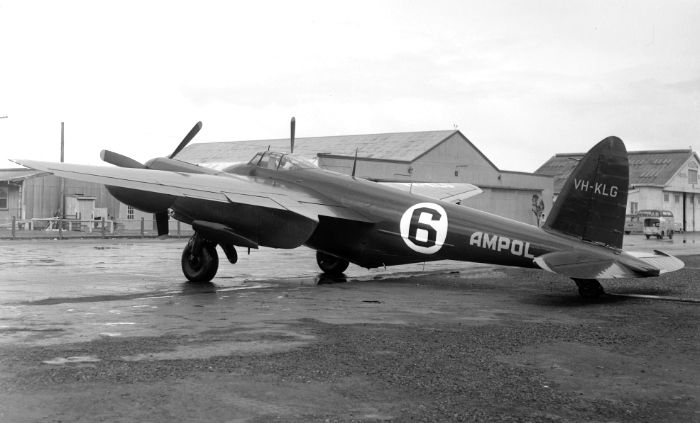
All red VH-KLG at Mascot Aerodrome, Sydney in September 1953. State Library of NSW
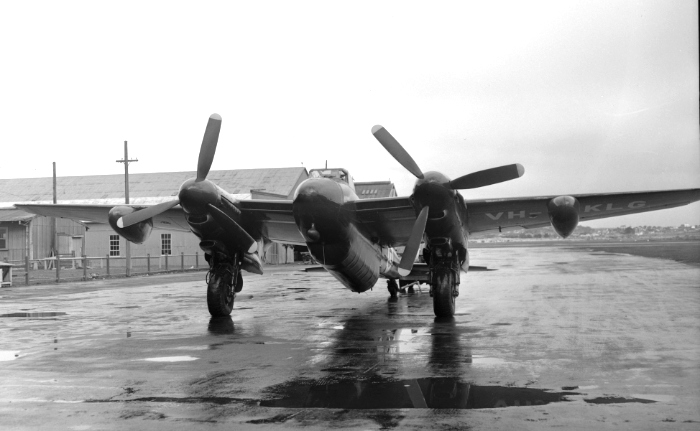
Mascot September 1953. This view shows the belly modification to install long-range fuel tanks. SLNSW
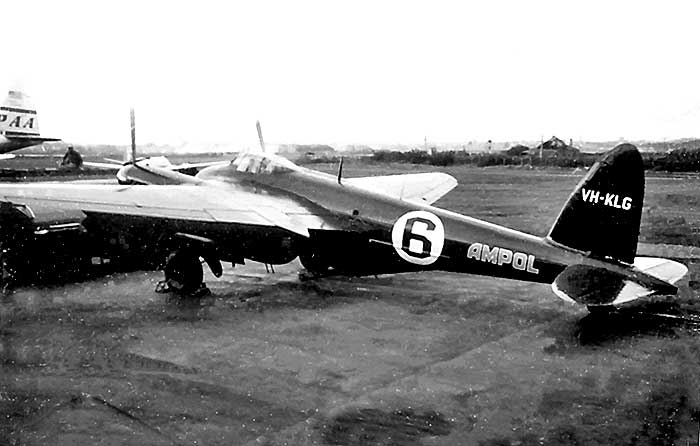
Behind is a Pan American Airways Boeing Stratocruiser.
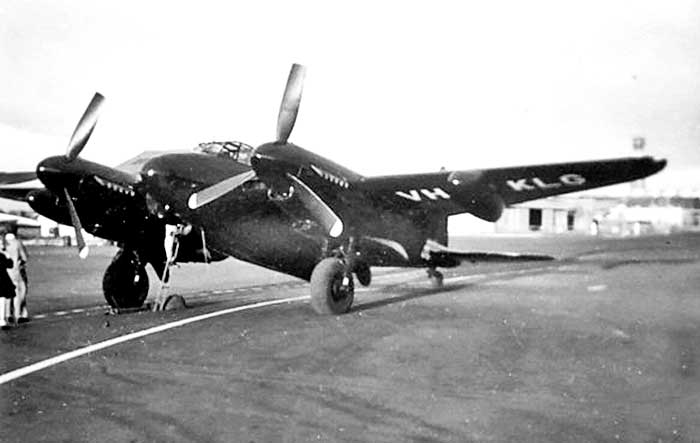
| 20.5.46 | Construction begun at Bankstown Aerodrome, Sydney by De Havilland Aircraft Pty Ltd. Built to RAAF order as a Mosquito FB Mk.40 A52-210 (Fuselage No. MN310) |
| Production delays and changing RAAF requirements resulted in this airframe being modified on the assembly line and completed as c/n 3236 as a PR. Mk.41 A52-319. | |
| 9.11.47 | Engines
installed on production line: two Packard Merlins built by Packard
Motor Car Co in Detroit Michigan in 12.44. Both had been received by
the DH Bulk Store, Sydney 4.4.46 from Commonwealth Aircraft
Corporation, Lidcombe NSW |
| 29.1.48 | First flight Bankstown, flown by DHA chief test pilot Brian R. Walker |
| 2.2.48 | Aircraft log: next text flight. Further test flights on the following two days |
| 12.2.48 | Acceptance flight by RAAF at Bankstown |
| 12.2.48 | Flown Bankstown to RAAF Richmond |
| 18.2.48 | Taken on RAAF charge as Mosquito PR41 A52-319. Received 2AD ex De Havilland Aircraft |
| 12.3.48 | Ferried Richmond-Archerfield on delivery to 3AD Amberley. Received 3AD Archerfield detachment |
| 16.3.48 | While airborne near Dubbo NSW pilot used fire extinguisher on an electrical fire in main switch panel |
| Category B Storage Archerfield, flown 2 hours per month | |
| 21.11.49 | Last flight Archerfield, prior to Category C Storage with no flying |
| 3.3.53 | Offered for disposal |
| 20.3.53 | Department of Supply sale contract for £100 to: James Woods, Perth WA |
| Remained stored at 3AD Archerfield detachment | |
| 22.8.53 | Test flown Archerfield and ferried to 3AD Amberley |
| 26.8.53 | Aircraft Log: next flight: Amberley local |
| Max Garroway later wrote: "From
1951 to 1954, I was the Test Pilot for 3AD Amberley. One of my duties
was to test and keep in flying condition the Mosquitos which were in
storage there. This dear old chap Jimmy Woods arrived at Amberley to
take delivery of a Mosquito. It is a bit of a jump from the
controls of an Anson to those of a Mosquito and I was a bit
apprehensive as I no longer had a Mossie with dual controls. Added to this was Jimmy's age which the best guess in the Mess was at least 70! So all I could do was take him up and give him a demo and a few circuits. Jimmy went off on his own, with me in the Control Tower talking him around and down, which he managed very well. He then asked me to fly the Mosquito to Perth with him and go with him in the air race. On the morning of our departure from Amberley he received a telegram advising that his race sponsor had decided to pull out. Jimmy was devastated but decided to go to Perth anyway." | |
| 7.9.53 | Aircraft Log: next flight: Amberley local, James Woods pilot check-out. Also 8.9.53 |
| 10.9.53 | Aircraft Log: Amberley-Perth, pilots Woods and Max Garroway |
| 23.9.53 | Registered VH-WAD James Woods, 22 Arbordale Flats, St Georges Terrace, Perth WA |
| RAAF markings painted over in silver and The Quokka was painted on the nose. Quokkas are small marsupial animals abundant on Rottnest Island, where Jimmy Woods operated his Woods Airways scheduled airline service from Perth with Avro Ansons VH-WAB & VH-WAC. | |
| In
the month prior to the race, Jimmy Woods' air race sponsor West
Australian Newspapers, withdrew support believing the entry of
Canberra jet
bombers and commercial airliners in the race gave the Mosquito no
chance of winning. Woods approached a prominent Sydney
businessman who was visiting Perth and was optimistic that he had
found a last-minute backer, but a week later received a telegam saying
time was too short to formalise an agreement. VH-WAD had been allocated race number 8, but it was never painted on the aircraft. | |
| 12.10.53 | Struck-off Register and Provisional CofA cancelled |
| 10.53 | An
offer to purchase VH-WAD came from M.J.Lawrence of Sepal Pty Ltd,
Sydney. Sepal was Australian agent for US operation World-Wide Surveys
Inc - see below |
| 1953-1961 | VH-WAD
was parked in the ANA hangar at Perth Airport for several years then
moved to the DCA hangar. The DCA file for VH-WAD records years of
increasingly acrimonious correspondence with Woods requesting him to
pay owed hangarage fees and his polite but deliberately vague replies. By 1961 when Woods Airways ceased operating because of DCA restrictions on Avro Ansons, James Woods owed the Department £900 hangarage. During 1961 DCA had the Mosquito towed out of their hangar and parked on an adjacent grass area |
| 11.1.63 | Airforce Association (WA Division)
sent a telegram to Woods at a London address where he was visiting
friends: AFA requested his permission to move the Mosquito into a
fenced compound at Perth Airport to be displayed alongside their Avro
Lancaster WU.16 which hasd recently been donated by the French Government and ferried from New Caledonia in December 1962 |
| 15.1.63 | Woods replied by telegram: "Bombs away, wish every success - Jimmy" |
| 1.2.63 | Towed
to an open site
behind the car park at Perth Airport and positioned with the the
Lancater. A cyclone wire fence was then erected around both aircraft,
which were opened to the public on Sundays for a small donation |
| Lack of a written agreement with Woods proved a problem when the Mosquito's condition quickly deteriorated due exposure to the weather. Woods ignored AFA and DCA requests to maintain the aircraft | |
| 2.3.67 | Perth
Airport Manager letter to AFA outlining his failed attempts to get
Woods' cooperation. Both DCA and AFA agreed the Mosquito's shabby
appearance made it unfit for display. He had sought the Crown
Solicitor's advice on how to legally remove it without the owner's
consent |
| 7.67 | Perth
Airport ground staff moved the Mosquito from the AFA Lancaster compound
to a dump area at a reservoir on airport land, out of public sight
behind trees |
| 5.68 | Unmoved,
still in fair condition. Woods had placed underneath the Mosquito two
spare Anson ailerons (still in RAAF yellow) previously held in storage |
| 8.68 | Perth
press reports that the cockpit entrance hatch had been wrenched off its
hinges and cockpit instruments removed. With the hatch no longer
secure, vandals had inflicted mindless interior damage. The upper wing
surface ply covering was wrecked by people walking out on the wings, breaking through the covering |
| 1.69 | Sold by Woods for $6,000 to James A. Harwood & Co, Perth WA Jim Harwood was a real estate agent who operated an import/export agency specialising in vintage motor cars. He had exported DH.82 Tiger Moth VH-AOY from Sydney to USA in December 1967 and wanted additional aircraft. He had arranged the shipping of Mustang A68-1 (ex Emu atomic test site in SA) from Adelaide to USA in 1968 and claimed he had salvage rights to two USAAC Bell P-39s which made forced landings near Weipa Qld during the war. The P-39s were later collected by North Queensland enthusiasts. |
| On-sold by Harwood to Edward A. Jurist, Vintage Car Store International Inc, Nyack, New York Ed Jurist was an early high profile warbird dealer involved with many imports and exports of ex-military aircraft. He was closely aligned with the Confederate Air Force in Texas and in 1969 imported 6 ex Peru Air Force P-47 Thuderbolts for the CAF. He was later a key partner in the recovery of 29 derelict Hawker Furies from Iraq and their subsequent world-wide sale as warbird restoration projects. | |
| 7-8.1.69 | VH-WAD dismantled at Perth
Airport for loading on trucks. Harwood said it would be sent by road to
Sydney where he intended to have it restored before being shipped to
USA. During loading, while being lifted by a crane, the fuselage structure failed and almost broke into two sections. Faced with the reality of the airframe's poor condition, Harwood abandoned the Sydney plans and put the dismantled aircraft into storage in Perth. |
| Sale to Ed Jurist cancelled due aircraft's structural condition | |
| 1969-1971 | Stored dismantled under cover at No.16 Wool Store, High Road, Fremantle WA |
| 2.3.71 | Harwood wrote to AFA (WA Division) offering the Mosquito plus $15,000 cash for their Lancaster. AFA declined the offer but indicated it was interested in acquiring the Mosquito for their planned aviation museum to be established at the AFA Estate, Bull Creek, Perth. Harwood refused to negotiate a price for the Mosquito separately |
| 6.71 | Sold by Harwood to David M. Kubista, 6159 East Seneca, Tucson Arizona Kubista claimed to be an airline pilot who owned a stable of warbirds at Tucson, racing Mustangs at Reno Air Races. However his name does not appear as an aircraft owner or in reports of the air races at Reno of the time, |
| 11.71 | Dismantled Mosquito airframe was moved from No.16 Wool Store due to space no longer available. The Merlin engines and propellers were stored under cover at Eagle Supplies, 14 Thurso Place, Myaree. While being lifted by crane, the fuselage, which was already broken behind the cockpit was damaged further and separated into two sections. These fuselage sections and the wing were trasnported to the yard of F.W. Churchers Company at Stockdale Road, O'Connor. There they were left on the ground along the wall of a work shed and covered with plastic sheeting. A pitiful sight. |
| 1.72 | Despite the sale to Kubista, Harwood made a new offer to AFA of $5,000 for the Mosquito "as is" |
| 4.72 | David
Kubista arrived in Perth to collect his Mosquito and organise its
shipping
to USA. When he saw the poor state of the aircraft and discovered that
a number of parts had been removed during storage, he made a press
appeal for these parts to returned. Kubista stated he had
commenced legal action against Harwood for misrepresenting the
condition of the aircraft |
| 5.72 | Fuselage sections and wing packed in heavy steel framework weighing 6 tons which had been constructed for the purpose |
| 20.5.72 | Packed airframe moved by road from O'Connor to Fremantle wharves for loading on board the freighter Manoora bound for Melbourne. Because hold cargo space was unavailable, it was loaded as deck cargo. At Melbourne it was planned to be transferred to Dilccara for shipping to Long Beach, California. Kubista said he expected it to reach Los Angeles on 18 June 1972 where he had made arrangements for it to be moved by road to Tucson AZ. He would then commence work on its restoration at Ryan Field near Tucson and he intended to fly it as an air racer |
| 23.5.72 | Manoora departed Fremantle for Melbourne |
| 5.72 | Mosquito in its frame was unloaded at Melbourne but the shipping agents would not load it on Dilcarra until costs already incurred by Kubista were settled |
| 72 | Placed in an open storage yard at Melbourne wharves while negotiations continued with Kubista |
| 2.75 | The
dismantled airframe unmoved in the open weather at Port Melbourne.
Kubista has not paid the shipping agents who want $6,000 to cover their
costs. The airframe is now derelict. |
| 22.1.79 | Auctioned at West
Melbourne to recover shipping, transport and storage costs which have
now risen to $18,000. Winning bid of $21,000 from Australian War Memorial, Canberra. |
| 1979-1996 | Restoration for display contracted to Bankstown Airport, Sydney by Hawker De Havilland Australia |
| 96 | Restored airframe moved to Canberra for final fitting out at AWM Mitchell Annexe |
| 22.1.97 | Rolled-out at Mitchell Annexe completed in RAAF post-war silver scheme as "A52-319" |
| Displayed inside Australian War Memorial, Canberra |
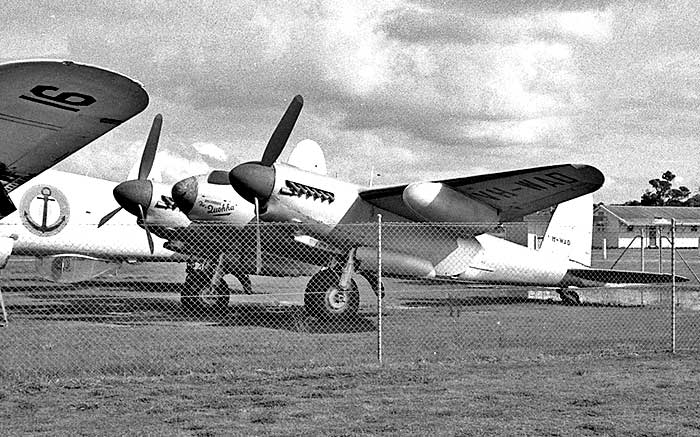
their French Aeronavale Lancaster WU-16 (NX622). Photo by Mike Madden
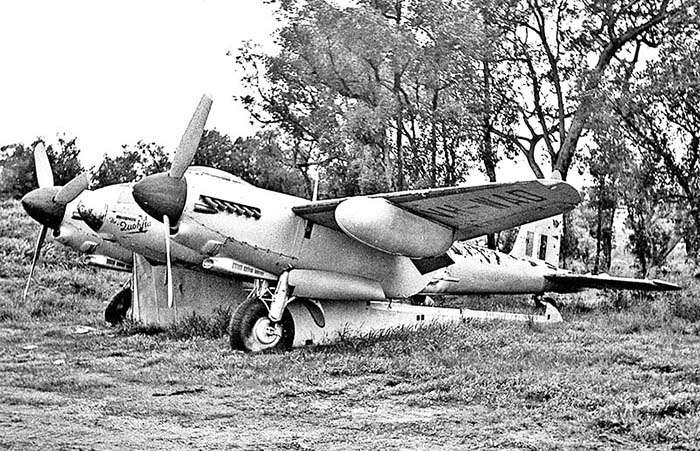
This picture in May 1968 shows the spare Anson ailerons which Jimmy Woods left under the Mosquito.
Photo by Geoff Goodall
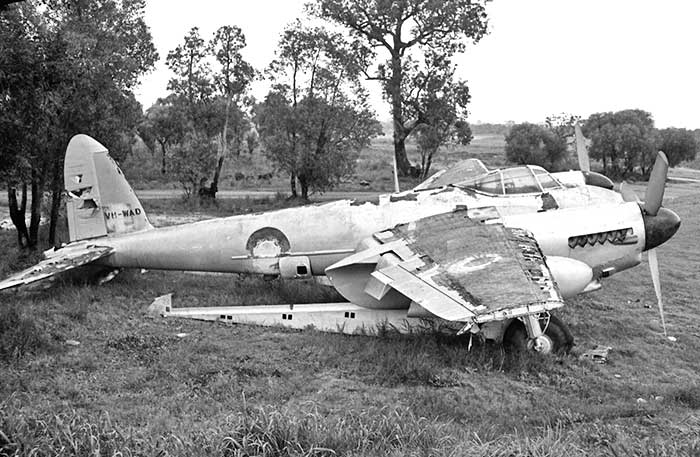
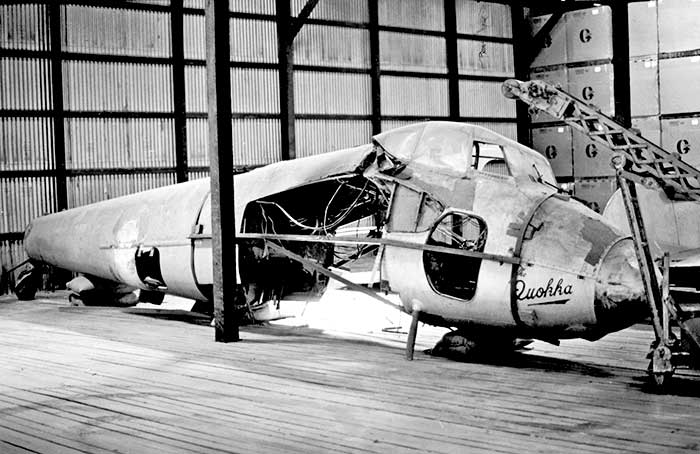
Photo by Geoff Goodall
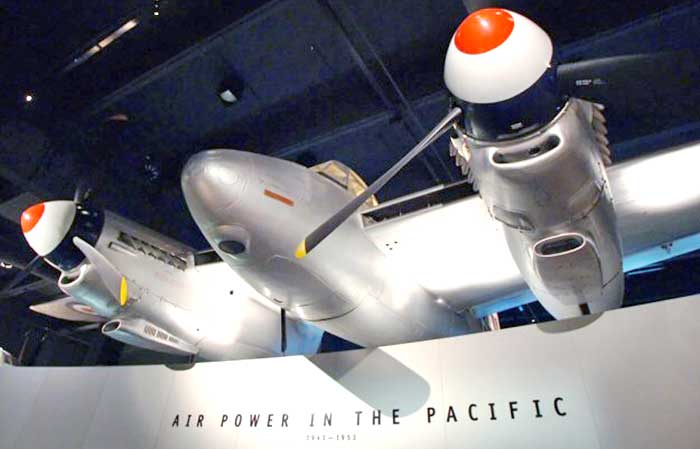
Photo by Phil Vabre
52 Wentworth Avenue, Mascot ("Sales Engineering Procurement Agencies and Loading") was formed as an agency to supply equipment, spare parts and services to airlines. Morry travelled as far as Lae, New Guinea on sales trips to take orders from Mandated Airlines.
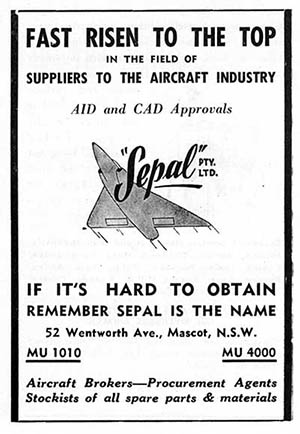
Aircraft Magazine November 1954
By the time Clair Waterbury arrived in Sydney, Morry Lawrence had established that the last of the RAAF Mosquito PR41s were still in service on aerial photographic survey work with 87 Squadron. Numbers of serviceable PR41s were stored in reserve at Amberley and Archerfield, Queensland but none would not be listed for disposal until the following year. However he did learn that three Mosquito FB40 instructional airframes at Ground Training Unit, RAAF Wagga NSW had just been sold to a scrap dealer. Hurried contact with the scrap dealer brought the news that they were in good condition, having been kept inside a hangar without any serious damage inflicted during their training role. An inspection found that A52-177 was best, and Sepal Pty Ltd purchased all three so that Merlin engines and parts could be exchanged to rebuild -177 to airworthy, after which remaining useful components would be sent to the Sepal parts store in Sydney.
Using his airline contacts, Morry Lawrence recruited aircraft maintence staff from Australian National Airways and Butler Air Transport in Sydney to work part-time on A52-177 at Wagga. Waterbury was happy with the deal and an AEC ferry pilot and navigator arrived to collect the Mosquito. Registered N4928V, it made the Pacific crossing in mid 1953 and was sold to a Californian charter airline.
| Constructed at Bankstown Aerodrome, Sydney by De Havilland Aircraft (Australia) Pty Ltd. Built to RAAF order as a Mosquito FB Mk.40. Fuselage number MN277 | |
| 8.3.46 | Taken on RAAF charge as Mosquito FB.40 A52-177. Received 2AD Richmond ex De Havillands |
| 8.4.46 | Received Ground Training Unit, Wagga ex 2AD. To be stored under cover |
| 20.1.47 | Approval for conversion to Instructional Airframe |
| 1.4.51 | Status: held at GTU with Merlin 33s Instructional Nos. 69 & 70 installed. Painted as "D1" |
| 23.9.52 | Offered for disposal |
| 14.1.53 | Sold by Department of Supply to R. H. Grant Trading Co Ltd, Melbourne Vic Grants was a scrap metal merchant which at that time specialised in breaking up large numbers of military aircraft at Wagga and Tocumwal NSW |
| .53 | Sold by R.H. Grant to M.J. Lawrence trading as Sepal Pty Ltd, Sydney Sepal also purchased Mosquitos A52-55 & A52-173 at Wagga from the same disposals sale |
| Sepal was acting as an agency for Aviation Export Co, Los Angeles CA This dealership, headed by Clair M. Waterbury, was interested in acquiring retired RNZAF and RAAF Mosquitos for resale to US aerial survey operators. The Mosquito's largely wooden construction made it an effective mount for magnetometer mineral survey, resulting in US and Canadian survey operators purchasing numbers of RAF Mosquitos in Britain. Waterbury also considered modifying Mosquitos as high-speed passenger aircraft with an all-metal forward fuselage capsule for pilot and three passengers. | |
| 53 | A52-55,
A52-173 and "D1" (A52-177) were parked outside at the aircraft
graveyard area at RAAF Wagga, where scrap dealers had been breaking up
aircraft for years |
| A52-177 was assessed
as in best condition. Morry Lawrence recruited aircraft maintence
engineers from Australian National Airways and Butler Air Transport to
work part-time at Wagga to get A52-177 back to airworthy condition,
using parts as required from A52-55 & A52-173. The latter two were then broken up for engines and parts, stored by Sepal Pty Ltd as spares. | |
| A52-177 had a radio
direction-finding loop antenna and cockpit fittings salvaged from an
Avro Anson were installed to aid navigation | |
| .53 | Registered N4928V Aviation Export Co, Los Angeles CA c/- Clair M. Waterbury US Civil Register quoted type as "De Havilland Mark 20", engines "Allison", constructed in 1953, identity "MN277": which was the DHA fuselage number |
| N4928V ferried
Wagga-Bankstown Aerodrome, Sydney by American pilot Lewis M. Leach who
worked for Aviation Export Co as a ferry pilot.He was accompanied by an Australian pilot, believed to have been Doug Swain | |
| N4928V inspected at Bankstown by De Havilland Aircraft Pty Ltd | |
| N4928V departed Sydney Airport on delivery to USA flown by pilot Lewis M. Leach and Navigator Elgin Long. Stowed on board the Mosquito were a quantity of spare parts. They had painted on the nose Press On Regardless | |
| Arrived Burbank California | |
| .54 | Sold to Richard R. Neumann/ California Air Charter Inc, Burbank Airport, California |
| California
Air Charter operated two other Mosquitos (N4935V and N9909F, both ex
RNZAF) on high speed parcel deliveries to Central and
South American countries, apparently often urgently-needed motor vehicle parts. Several magazine articles have reported that
California Air Charter used them for CIA
clandestine operations in Central and South America, but CAC President Richard
Neumann strongly denies this. In a 2002 letter he says all consignments
carried were "strictly legal and above board, with the consignees usually being the destination port's head customs officer." | |
| | Sold to Poddy Mercer/ Mercer Enterprises Inc, Burbank Airport California |
| Retired Burbank | |
| Sold for scrap to James Kaplan, Sun Valley CA. Broken-up by Kaplan at Burbank | |
| US Civil Register shows last owner as Howard B. Crawford, Los Angeles, California | |
| Broken-up at Burbank Airport CA | |
| During
the 1980s the Merin engines and metal airframe components of N4928V
were found in storage at Burbank Airport. They were acquired by Jim Merizan, Yorba Linda, California
for use in his restoration of three derelict Mosquito airframes.
Nothing has been heard of this ambitious project for some time. |
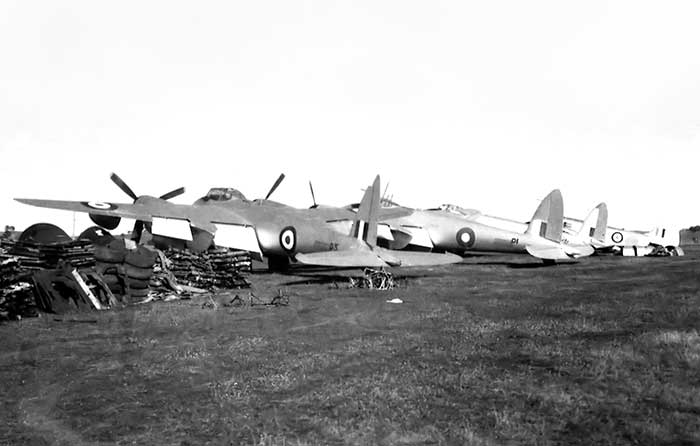
A52-177 is in centre painted with instructional airframe number "D1"
B&W photos in this set were taken by Morry Lawrence, courtesy Doug Morrison


Note the legs protruding from the fuselage hatch



|
Sepal Pty Ltd became Australian agents for World-Wide Surveys Inc, Philadelphia, Pennyslvania. This was an operation formed as a joint venture between two established US aerial survey companies, Aero Service Corp, Philadelphia and Fairchild Aerial Surveys Inc, Los Angeles, California.
This allowed both to pool resources to bid for lucrative survey jobs mostly outside USA. In early 1954 World-Wide Surveys Inc was awarded a high altitude (36,000 feet) photographic survey contract by the US Army Map Service to cover large areas of Sarawak and Sabah in Borneo. WWS wanted to use Mosquitos for the contract and Morry Lawrence advised them that suitable aircraft were available from RAAF or RNZAF disposals. Lawrence promptly registered a new Sepal associate company Word Wide Aerial Surveys (Australia) Ltd. With commercial pressure mounting to begin the Borneo contract, Aero Service Corp sent its Operations Manager Joe Mullen to New Zealand and Australia to acquire Mosquitos and get them to Borneo. Arriving in Melbourne in early May 1954, Mullen selected the two RAAF Mosquito PR.41s with lowest airframe hours on the Department of Supply disposals list: A52-306 & -313 were purchased plus a stock of spare Merlin engines and parts. RAAF pilot Max Garroway, who at that time was the No.3 Aircraft Depot Test Pilot at RAAF Amberley for their stored Mosquitos takes up the story: "I was sitting in my office at Amberley one day in May 1954 when a gentleman appeared and introduced himself as Joe Mullen from Aero Service Corporation in USA and informed me "I have just bought one of your Mosquitos". I had A52-306 at Amberley and the other one was at Tocumwal. I ferried both to Mascot where an engineer from Aero Service Corp (George Maisenhalter) carried out some modifications and they became N1596V and N1597V. The modifications were to accommodate a photographer position in the rear fuselage, cut a hole in the floor of the fuselage to take the big Fairchild camera and convert the oxygen system from high pressure to the American 'demand' low pressure system. I note from my log book that on 30 May 1954 I took Joe Mullen up on an altitude test to 36,000 feet from Mascot and I can remember that he was most impressed with the Mossie's performance, which he said was better than the P-38 Lightnings that Aero Service operated for survey at these altitudes. Joe Mullen needed two pilots. He recruited Bruce Mackenzie from East West Airlines who had flown Mossies during the war, so I gave him a refresher and check-out at Mascot. Joe then offered me a job. I tried to get leave without pay for six months from RAAF but they would not agree. Joe then made me an offer which, financially, was almost impossible to refuse. So I resigned my commission and took on the job of flying and looking after the maintenance of the two aircraft. The Aero Service engineer returned to the States and we recruited two mechanics Tony Maurer and Paddy McCarthy from TAA. Bruce and Tony Maurer went ahead to Labuan, Borneo under some urgency because the company was being paid on some kind of cost-plus basis and received a payment for every day an aircraft was on site and servicable. I followed with Joe Mullen and Paddy came up by airlines." |
Normally magnetometer survey aircraft had the sensor installed at the end of a "stinger" or towed in a "bird" away from the interference of the aircraft's metal structure. Homer Jensen believed he could install an effective sensor inside the fuselage of the mostly wooden Mosquito, and N1597V was modified at Camden to fit the electronic equipment and operator's seat within the claustrophic fuselage shell. Despite its wooden structure, the Mosquito was found at first to be magnetically "noisy"and required major cutting of the fuselage bonding strips and replacement of the control cabling in stainless steel. After flight trials at Camden, Max Garroway departed for Broome WA where the survey was based for the next four months.
Sepal Pty Ltd operated other surveys 1955-1957 under its own DCA Airwork Licence on behalf of World-Wide Surveys, using a Lockheed Hudson VH-SMM (leased from Sydney Morning Herald) for photographic survey and Avro Anson VH-BLF equipped with magnetometer sensor for mineral survey. Max Garroway and Ken Rowlands were the usual pilots for the Hudson and Les Taylor flew the Anson. In 1956 Morry Lawrence engaged experienced airline ground engineer Noel Notley as Sepal's senior engineer, in charge of maintenance at the Camden hangar. Notley left Butler Air Transport and moved his family to live at Camden.

Photo: Ed Coates collection
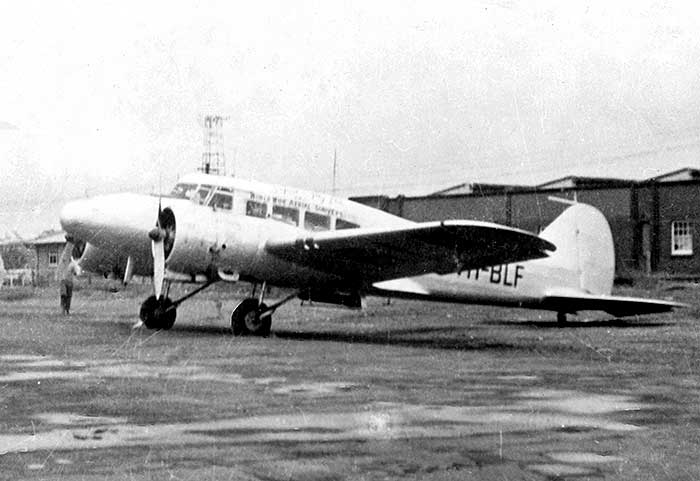
stowed in its cradle under the belly. Photo: Ian McDonell collection
 |  |
| Built at Bankstown Aerodrome, Sydney by De Havilland Aircraft (Australia) Pty Ltd. Built to RAAF order as a Mosquito FB Mk.40 A52-197. Fuselage number MN297 | |
| .47 | Production delays and changing RAAF requirements resulted in this airframe being modified on the assembly line and completed as a PR. Mk.41 A52-306 |
| 5.8.47 | Taken on RAAF charge as Mosquito PR.41 A52-306. Received 2AD Richmond ex De Havillands |
| 13.8.47 | Received Survey Squadron, Canberra ex 2AD. Survey Squadron code SU-S |
| 29.1.48 | Ferried Canberra-Broken
Hill NSW to join a Survey Squadron 6 week detachment at Broken Hill to
complete photographic mapping of a survey area commenced at Oodnadatta
SA the previous year covering Leigh Creek, Lake Frome, Woomera,
Middleack ranges and Harts Ranges. A52-306 was crewed by Flt Lt Charles Melchert and navigator Sam Jordan |
| 8.3.48 | Survey Squadron reformed as No. 87 (Survey) Squadron, Canberra. Changed 11.49 to 87 (PR) Squadron Mosquitos operated all silver without squadron codes |
| 4.4.49 | Received De Havilland Aircraft Bankstown ex 87 Sqn for servicing |
| 6.9.49 | Received RAAF Station Canberra ex DH for storage |
| 16.3.50 | Received 87 Sqn ex RAAF Canberra |
| 28.3.50 | Departed Canberra on ferry
to 87 Sqn detachment at Alice Springs NT and commenced survey flying
from Alice Springs the following day |
| 3.8.50 | Returned to Canberra after task completed by Alice Springs detachment |
| 27.9.50 | Received De Havilland Aircraft Bankstown ex 87 Sqn for major servicing |
| 28.5.51 | Ferried Bankstown-Canberra, crew Flt Lt Vic Guthrie, and M.Wood Received RAAF Station Canberra ex DH |
| 31.5.51 | Received 87 Sqn ex RAAF Canberra |
| 5.6.51 | Following flights extracted from pilot logbooks: Canberra, instrument approach training, crew Flt Lt Waugh, M.Wood |
| 28.6.51 | Canberra-Longreach (3 hrs 15 mins) crew Sgt Waugh, M.Woods |
| 6.51-10.51 | Based with Longreach Detachment Qld on aerial mapping |
| 18.7.51 | Power
lost on both engines after takeoff Longreach, Flt Lt Vic Guthrie
returned for emergency landing, both engines lost all power, pilot made
dead-stick landing. No damage to airframe. |
| 8.8.51 | Longreach Nav exercise, crewWaugh and Woods. Also 9.8.51 |
| 10.8.51 | Longreach-Cloncurry-Townwsville-Longreach, crewWaugh and Wood |
| 4.10.51 | Longreach mapping flight, crew P/O Strange and Wood (4 hrs) |
| 16.10.51 | Longreach-Cloncurry-Longreach, crew Waugh and Wood |
| 17.10.51 | Longreach survey, crew Waugh and Wood. Also 18.10.51 |
| 1.11.51 | Canberra-Richmond,
flew demonstrations of propeller feathering and unfeathering to Chief
of the Air Staff, AVM McCauley, then Richmond-Canberra. Ctrew McKenzie
and Jordan |
| 3.11.51 | Canberra local, training exercise, crew McKenzie and Sgt Glassey |
| 5.11.51 | Photo exercise Sydney and Newcastle, Sqn Ldr Browne and Jordan |
| 7.11.51 | Canberra-Bourke-Canberra at 20,000 feet, crew McKenzie and Flt Lt Ivan Pretty |
| 13.11.51 | Canberra-Mallala cross-country training (5hr 30 min), crew Strange and Jordan. To Canberra next day |
| 15.11.51 | Canberra, photography, crew Waugh and Wood |
| 22.11.51 | Canberra-Amberley-Canberra,
fighter affliliation, crew Waugh and Wood. Simulated attack on Brisbane
at 20,000 feet, Mustang defenders unable to reach that altitude.
Returned to Canberra next day |
| 26.11.51 | Canberra, photography exercise including oblique camera trails |
| 20.5.52 | Received De Havilland Aircraft Bankstown ex 87 Sqn for major servicing |
| 30.4.53 | Received 2AD Richmond ex DH |
| 14.5.53 | Received 3AD Amberley ex 2AD for storage |
| 2.6.53 | Amberley, flypast Brisbane for Coronation of Queen Elizabeth II |
| 18.7.53 | Amberley-Richmond-Tocumwal, return to Amberley next day, pilot Max Garroway (3AD test pilot) |
| 28.7.53 | Navy cooperation (2 hrs 15 mins), pilot Garroway |
| 10.8.53 | Amberley-Dubbo-Amberley, pilot Garroway |
| 1.9.53 | Amberley-Dubbo-Amberley, pilot Garroway |
| 3.9.53 | Amberley-Townsville, return to A20.9.53mberley next day, pilot Garroway |
| 20.9.53 | flying display for Air Force Week, pilot Garroway |
| 4.12.53 | Amberley-Rockhampton-Amberley, pilot Garroway |
| 18.12.53 | Amberley-Laverton-Amberley, pilot Garroway |
| 4.1.54 | To be stored at Amberley Category B under cover |
| 2.2.54 | Amberley test flight, pilot Garroway |
| 15.3.54 | Amberley-Williamtown-Richmond-Williamtown-Amberley, pilot Garroway |
| 22.3.54 | Amberley-Charleville (night circuits)-Amberley, pilot Garroway |
| 2.4.54 | Amberley-Archerfield-Amberley, pilot Garroway |
| 30.4.54 | Amberley-Laverton-Amberley, pilot Garroway |
| 5.54 | Sold by Department of Supply to World-Wide Surveys Inc, Philadelphia PA |
| 5.5.54 | Joe Mullen of World-Wide Surveys arrived Amberley to collect A52-313 |
| 17.5.54 | Ferried
Amberley to Sydney Airport by RAAF 3AD officer Max Galloway and Joe
Mullen (Aero Service Corp). Garroway was then engaged by WWS as a
Mosquito survey pilot |
| Inspection at Bankstown by De Havilland Aircraft Pty Ltd for US certification. Modified by Aero Service Corp engineers to install a Fairchild vertical camera and operator position inside the rear fuselage. | |
| 29.5.54 | Registered N1596V Fairchild Aerial Surveys Inc, Los Angeles, California, operated by World-Wide Surveys Inc, Philadelphia PA |
| 29.5.54 | US CofA issued at Sydney |
| 29.5.54 | N1596V local flying Sydney (2 hr), Max Garroway instructing Bruce McKenzie engaged by WWS |
| 30.5.54 | N1596V altitude test flight to 35,000 feet, Max Garroway and Joe Mullen |
| 31.5.54 | N1596V general test flight, Max Garroway and Joe Mullen |
| DCA file memo: "Two photo-reconnaissance Mosquito aircraft were acquired from disposals by Mr. M. Lawrence of Sepal Pty Ltd, acting as agents for an American aerial survey organisation Word-Wide Surveys Incorporated. The aircraft were processed by De Havilland Aircraft Pty Ltd, Sydney for the issue of United States Registration and Airworthiness certificates. These documents were issued by a CAA representative during one of the regular visits by these officers to Sydney to inspect the maintenance organisation of Pan American Airways at Sydney. Registration marking and certificates were issued to one aircraft N1596V on 29 May 1954 and the other N1597V on 7 June 1954." | |
| Early 6.54 | Departed
Sydney on ferry to Labuan, Borneo for high level photographic mapping
contract, flown by Bruce McKenzie, with ground engineer Tony Maurer. Refuelled at Cloncurry, Darwin, Surabaya. Aircraft impounded and crew held for several days by Indonesian military at Surabaya on suspicion of unauthorised photography of Indonesian territory. |
| 6.54 | Reached Labuan |
| N1596V and N1597V flew high altitude aerial photographic mapping runs from Labuan, pilot MacKenzie with a navigator and camera operator from Aero Service Corp. A palm frond hangar had been constructed by the American team on the wartime airfield to provide some shade for the Mosquitos. | |
| 7.54 | Palm frond hangar collapsed during a storm, covering N1596V with fronds and debris. No serious damage |
| 21.9.54 | N1596V & N1597V arrived Darwin from Labuan via Sorong at the completion of the Borneo survey. Both continued to Camden NSW where they were stored in a hangar leased by Sepal Pty Ltd and occasionally test flown by Max Garroway |
| 10.55 | DCA file memo: both Mosquitos are in the Sepal hangar at Camden |
| M.J.Lawrence
of Sepal Pty
Ltd and World Wide Aerial Surveys (Australia) Ltd, acting as agent for
World-Wide Surveys
Inc negotiated with DCA for approval to extend Mosquito survey work
into
1957. Departmental policy restricted Australian civil certification of
former military combat aircraft types because of the probability of
unrecorded airframe stresses sustained in military service. Because
they were US registered, DCA had approved their use in Australia only
for specialist survey work. On 29.6.56 DCA Head Office gave approval for Sepal Pty Ltd to operate two Mosquitos "for a period not exceeding 12 months for the limited purpose of high level aerial photography only." Requirements were that US civil registrations must be cancelled and the aircraft registered in Australia. DCA still had serious concern over the emergency evacuation of the camera operator in the event of a belly landing. Sepal responded detailing their safety procedures. If an emergency landing was required, the camera operator would be instructed by the pilot to bale out while at a safe altitude - 10.8.56 DCA aircraft surveyor report describing simulated evacuations of the camera operator from a Sepal Mosquito in Hangar 55 at Camden. The evacuations by a crewman 6 feet heigh weighing 14 stone (80Kg) took 50 seconds, which failed the DCA ANO time limit. | |
| 10.7.56 | US Bill of Sale: from Fairchild Aerial Surveys Inc to World Wide Aerial Surveys (Australia) Ltd, Sydney c/- M.J.Lawrence |
| 20.7.56 | Cable
to DCA from CAA, Washington DC advising that registration of N1596V had
been cancelled on receipt of a Bill of Sale to an Australian owner. |
| 20.7.56 | DCA
file: copy of letter to CAA from World Wide Aerial Surveys (Australia)
Pty Ltd, Sydney advising that N1596V has been sold to Sepal Pty Ltd, Sydney |
| 24.7.56 | Application forms for CofR and CofA for Mosquito A52-306 submitted to DCA by Sepal Pty Ltd. VH-WWS was requested |
| 15.10.56 | Test
flight as VH-WWS at Camden, pilot Max Garroway. This followed overhaul
for Australian certification, supervised by Sepal chief engineer Noel
Notley. Airframe total time 1,270 hours. |
| 2.11.56 | Registered VH-WWS Sepal Pty Ltd, Sydney NSW |
| 2.11.56 | Restricted CofA issued valid only until 1.8.57 |
| Sepal
camera operator Kevin Pavlich logbook extracts for VH-WWS (occasional
flights, while he was camera operator on Hudson VH-SMM), Ken Rowlands
was pilot for all the following Mosquito flights, with two Fairchild
Aerial Surveys instructors from America acting as navigator in the
right seat. 7.12.56 Camden test flight to 15,000 feet, stbd engine power fluctuation 17.12.56 Camden-Mascot 21.12.56 Mascot-Camden, test flight to 17,000 feet, u/s stbd engine 27.12.56 Altitude test, stbd engine failed on takeoff 28.12.56 Altitude test, stbd engine u/s, second flight to 25,000 feet 2.1.57 Camden-Mascot 4.1.57 Photo test at 35,000 feet, navigator unwell at 25,000 feet 8.1.57 Photography at 25,000 ft Orange district, then various days January over Cooma, Wollongong 11.1.57 Cabin hatch blew off at 25,000 feet over Tumut 29.1.57 Mascot, radio u/s 4.2.57 test flight radio check 12.2.57 test flight radio and generator checks 19.2.57 Mascot-Camden (Kevin Pavlich and Ken Rowlands then left Sepal Pty Ltd to join Adastra Aerial Surveys, Sydney. Israeli pilot Gerry Vardi took over from Rowlands flying VH-WWS) | |
| 13.7.57 | VH-WWS cleared Customs outbound at Darwin for a survey at Portuguese Timor. Captain Gerry Vardi. Among crew was American citizen Ray E. Anderson, photogrametric engineer (Immigration file record) |
| 23.7.57 | In
response to a request from Sepal Pty Ltd, DCA granted a one month
extension to the CofA from 1.8.57 to 1.9.57 to allow completion of the
survey |
| 15.8.57 | VH-WWS cleared Customs inbound at Darwin. Ray Anderson in the crew. |
| 8.57 | VH-WWS retired at Camden |
| 20.8.57 | Letter to DCA from Sepal
Pty Ltd advising that "VH-WWS is presently stored in our hangar at
Camden and it is no longer our intention to use this aircraft in our
operations." |
| 20.8.57 | Struck-off Civil Register |
| 58 | VH-WWS and N1597V stripped airframes burnt at Camden NSW |
| Noel
H. Notley, former Sepal Pty Ltd chief engineer at Camden had joined with
Morry Lawrence to form Lawrence Engineering and Sales Pty Ltd in August
1957 to take over the licenced workshop in the Camden hangar. (see DH.82 Tiger Moths-LES production in this series). Noel later wrote: "We started to dismantle the two Mosquitos, selling the engines, propellers, hydraulic components, oxygen systems, instruments and radios over a 6 to 9 month period. It then reached a point where it was not viable for them to occupy hangar space. So the two Mosquitos were towed out to a clear area on the aerodrome, jacked up to remove the wheels and let down on the undercarriage legs. Petrol was spilled in and around the aircraft and they were set alight. Being wooden construction, they burnt to the ground. The remaining metal components were cleared up and dumped at the tip." |
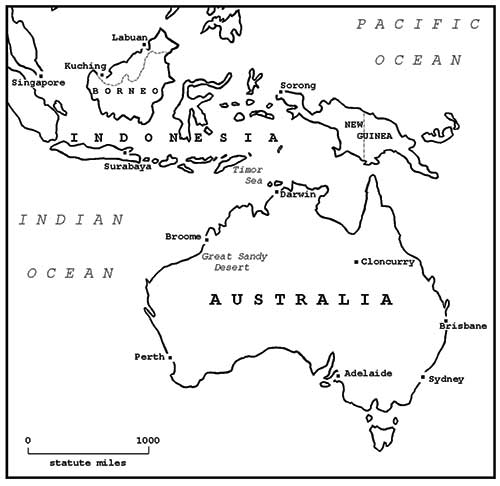
Map courtesy Doug Morrison

Photo: Aero Service Corp via Norm Malayney
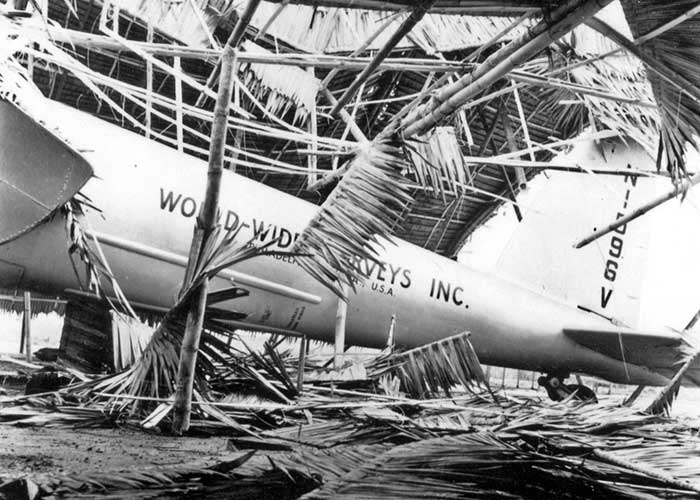
Photo by Max Garroway via Doug Morrison
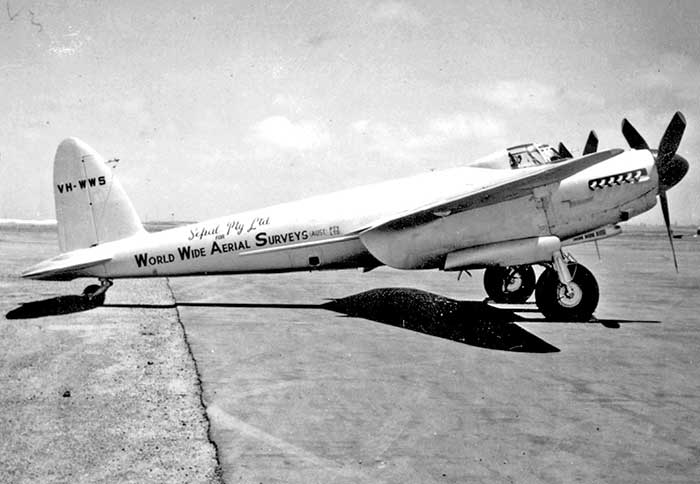
Photo by Frederick G. Freeman via Norm Malayney
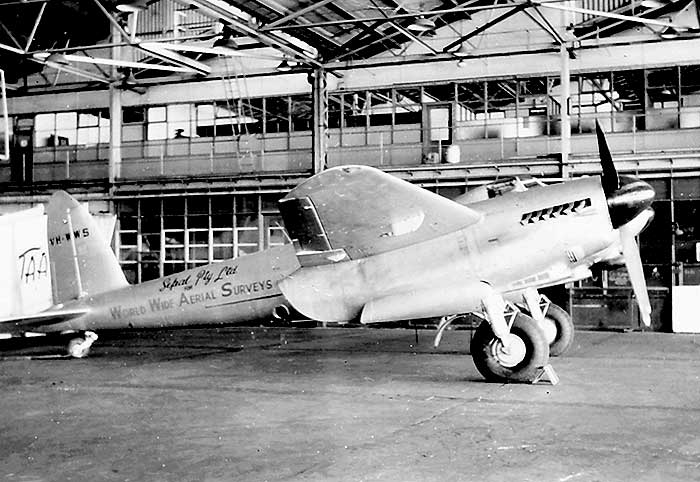
VH-WWS
parked overnight in a TAA hangar at Mascot in 1957.
Photo by Eddie Coates
| Built at Bankstown Aerodrome, Sydney by De Havilland Aircraft (Australia) Pty Ltd. Built to RAAF order as a Mosquito FB Mk.40 A52-204 | |
| .47 | Production delays and changing RAAF requirements resulted in this airframe being modified on the assembly line and completed as a PR. Mk.41 A52-313 |
| 7.11.47 | Taken on RAAF charge as Mosquito PR.41 A52-313. Received 2AD Richmond ex De Havillands |
| 10.12.47 | Received 3AD Amberley ex 2AD for storage |
| 7.2.51 | Received 87 Squadron, Canberra ex 3AD to incorporate mods |
| 14.2.51 | Received 1AD Laverton to incorporate mods |
| 4.4.51 | Ferried Laverton-Canberra, Flt Lt Guthrie and Flt Ltd Sam Jordan. Received 87 Squadron ex 1AD. Based Townsville until 3.5.51 |
| 26.4.51 | Received 87 Sqn detachment Townsville Qld. Flown daily on survey by Guthrie and Jordan until 3.5.51 |
| 3.5.51 | Issued 87 Sqn Canberra ex Townsville detachment |
| 9.5.51 | Minor
damage landing Canberra, returning from Cooma with one engine shut
down, Sgt B.Waugh and navigator Mike Wood. Aircraft ran off the end of
runway and damaged. Repairable at unit. Serviceable next day. |
| 17.5.51 | Following flights extracted from pilot logbooks: Canberra local flying, crew Guthrie and Wood |
| 24.5.51 | Canberra local, crew Guthrie and Wood |
| 5.6.51 | Local flying Canberra, instrument approach training, crew Waugh and.Wood |
| 27.6.51 | Navex Canberra-Sale-Canberra, crew Guthrie and Jordan |
| 28.6.51 | Canberra-Canberra, two low-level exercises, one by day, one at night, crew Guthrie and Jordan |
| 2.7.51 | Canberra-Williamtown-Schofields-Canberra , cross-country nav exercise, crew Waugh and Wood |
| 3.7.51 | Canberra local training, crew Waugh and Wood |
| 10.7.51 | Canberra test flight after maintenance, crewWaugh and Wood |
| 25.7.51 | Photographic mission (4 hr 20 min), crew Sqn Ldr Claude Browne and Jordan |
| 6.8.51 | Canberra-Longreach (3 hr 50 min), crew Waugh and Wood, to join the 87 Sqn Longreach detachment |
| 7.8.51 | Photo mapping ex Longreach: between Brisbane and Williamtown, crew Browne and Jordan (6hr 5 min) |
| 8.8.51 | Williamtown-Canberra, crew Browne and Jordan |
| 16.8.51 | Canberra-Longreach, night ferry, crew Ted McKenzie and Jordan |
| 18.8.51 | Longreach-Brisbane-Canberra nav training, crewTed McKenzie and Jordan (4 hr 30 min) |
| 15.9.51 | Canberra-Canberra: flypast at Sydney ceremony Battle of Britain anniversary, crew Browne and Jordan |
| 10.10.51 | Fighter affiliation exercise, crew McKenzie and Jordan |
| 15.10.51 | Photgraphy Melbourne, crew P/O Jones and Jordan |
| 29.10.51 | Navigation exercise, crew P/O Strange and Jordan |
| 1.11.51 | Canberra-Sydney, engine trouble, returned to Canberra, crew McKenzie and Jordan |
| 7.11.51 | Canberra photography flight, crew Waugh and Wood. Repeated next two days same crew |
| 10.11.51 | Fighter affiliation, crew McKenzie and Waugh |
| 13.11.51 | Canberra, photography exercise, crew Waugh and Wood |
| 16.11.51 | Canberra, photographic survey Cessnock and Singleton, crew McKenzie and Flt Lt Pretty |
| 20.11.51 | Canberra-Archerfield photography at Nowra and Brisbane. Returned to Canberra next day |
| 29.11.51 | Canberra, photographic survey Singleton, Cessnock, Broken Bay, crew McKenzie and Jordan |
| 2.12.51 | Canberra, photograhic survey between Canberra and Cessnock, crew Sgt Gordon and Wood |
| 19.12.51 | Test flight, crew McKenzie and Sgt Davenport |
| 21.1.52 | Test flight, crew McKenzie and F/O Scotland |
| 12.2.52 | Canberra-Mallala
(2hr 40min), next day Mallala-Pearce (5hr 10min) to join 87 Sqn Pearce
WA detachment, crew W/O Hunt and Mike Wood |
| 15.2.52 | Pearce, photographic survey, crew Hunt and Wood. Also February 18, 21, 22, 26, 27, 28 |
| 25.2.52 | Pearce, photographic training, crew McKenzie and Jordan |
| 3.3.52 | Pearce, photographic survey, landed Kalgoorlie (6hrs 20 min). Crew Hunt and Woods. Returned to Pearce next day with survey enroute (5hr 55min) |
| 13.3.52 | Pearce, photographic survey, crew Hunt and Wood. |
| 14.3.52 | Pearce, photographic survey, landed Carnarvon. Returned to Pearce same day, crew Hunt and Wood. |
| 17.3.52 | Pearce, photographic training and fighter affiliation, crew McKenzie and Jordan |
| 18.3.52 | Pearce, photographic survey, crew Hunt and Wood. |
| 20.3.52 | Pearce, photographic survey, landed Kalgoorlie. Returned to Pearce, crew McKenzie and Jordan |
| 26.3.52 | Pearce, photographic survey, crew Hunt and Wood. |
| 1.4.52 | Pearce, photographic survey, crew Hunt and Wood. |
| 2.4.52 | Pearce-Wagga-Canberra, crew Hunt and Wood. |
| 1.5.52 | Canberra, photographic survey, crew Hunt and Wood |
| 2.5.52 | Canberra-Williamtown-Canberra, photographic survey, lcrew Hunt and Wood |
| 21.5.52 | Canberra, photographic survey, crew Hunt and Wood |
| 28.8.52 | Canberra, photographic survey Goulburn, Gunning, crew Flt Lt Laddie Hindley and Wood |
| 26.9.52 | Canberra, photographic survey Jervis Bay,Wagga, crew Hindley and Wood |
| 1.10.52 | Canberra night flyig training, pilot Hindley |
| 3.10.52 | Canberra-Bankstown, crew McKenzie and Wood. Received De Havilland Aircraft, Bankstown ex 87 Sqn for major service |
| 6.3.53 | Held u/s at DH |
| 15.11.53 | Received 2AD Richmond ex DH |
| 5.54 | Sold by Department of Supply to World Wide Surveys Inc, Philadelphia PA |
| 22.5.54 | A52-313 ferried Tocumwal to Sydney Airport, Flt Lt Max Galloway and Joe Mullen (Aero Service Corp) |
| Modified at Sydney by Aero
Service Corp engineers to install a Fairchild vertical camera and
photographer position inside the rear fuselage | |
| 7.6.54 | Registered N1597V World Wide Surveys Inc, Philadelphia PA |
| 7.6.54 | US CofA issued at Sydney |
| DCA file reference: "Two photo-reconnaissance Mosquito aircraft were acquired from disposals by Mr. M. Lawrence of Sepal Pty Ltd, acting as agents for an American aerial survey organisation Word-Wide Surveys Incorporated. The aircraft were processed by De Havilland Aircraft Pty Ltd, Sydney for the issue of United States Registration and Airworthiness certificates. These documents were issued by a CAA representative during one of the regular visits by these officers to Sydney to inspect the maintenance organisation of Pan American Airways at Sydney. Registration marking and certificates were issued to one aircraft N1596V on 29 May 1954 and the other N1597V on 7 June 1954" | |
| 12.6.54 | Departed
Sydney on ferry to Labuan, Borneo for high level photographic mapping
contract, flown by Garroway and Mullen. Refuelled at Cloncurry,
Darwin, Sorong (Netherlands New Guinea), arrived Labuan 15.6.54 |
| Flew aerial mapping missions from Labuan, pilot Garroway with a navigator and camera operator from Aero Service Corp | |
| 7.54 | Palm frond hangar
collapsed during a storm, covering N1597V with fronds and debris.
Torn fabric on the vertical tailplane was quickly repaired |
| 21.9.54 | N1596V & N1597V arrived Darwin from Labuan via Sorong at the completion of the Borneo survey. Both continued to Camden NSW. N1597V was flown by Max Garroway, who routed via Brisbane to visit his wife. At Camden they were stored in a hangar leased by Sepal Pty Ltd and occasionally test flown by Max Garroway |
| 5.55 | Modified
at Camden for mineral survey by a US team headed by Aero Service Corp's chief scientist Homer Jensen. A magnetometer was installed inside the fuselage with an operator position. |
| 5.55 | Test flights at Camden to trial the magnetometer sensor |
| 21.5.55 | N1597V departed Camden for Broome WA to conduct an oil search over the Canning Desert for WA Petroleum Co. Flown by Garroway, with navigator Richard Brown and magetometer operator Vince Bertino, the Mosquito was maintained at Broome by engineers Tony Maurer and Paddy McCarthy |
| 8.7.55 | Starboard Merlin failed while over desert, Garroway returned
to Broome and attempted to jettison the two wing drop tanks which were
full of fuel. The starboard tank would not release, causing a difficult landing. |
| 3.9.55 | Broome survey completed. N1597V ferried to Perth WA for a small survey job |
| 3.9.55 | Max Garroway logbook: Local flight Perth. Also 4th and 6th September |
| 9.9.55 | Max Garroway logbook: Perth survey (completed in one day) |
| 10.55 | DCA file memo: both Mosquitos are in the Sepal hangar at Camden |
| 7.56 | N1597V test flown at Camden, fitted for high altitude photographic survey. Pilot Max Garroway |
| 8.56-10.56 | N1597V flown on a high altitude photographic survey of northern NSW, based Tamworth. Crewed by Captain Max Garroway, copilot/navigator Ken Rowlands and camera operator Kevin Pavlich, all three transferred from the Hudson VH-SMM leased by Sepal for World Wide Surveys. |
| Kevin Pavlich logbook extracts for N1597V: 5.8.56 Dubbo camera test flights 8.8.56 Sydney Harbour camera run 25,000 feet 10.8.56 Camden-Tamworth, based Tamworth next two months 14.8.56 commenced 25,000 ft photo survey runs northern NSW, many days abandoned due cloud 29.10.56 landed Coffs Harbour after flying Lines 16 & 5 at 25,000 ft outside air temperature -24C 30.10.56 ferried Tamworth-Camden, 55 mins (right hand seat) | |
| 30.10.56 | Arrived Camden from Tamworth survey job. |
| 11.56 | Retired and parked in the Sepal hangar at Camden. N1596V became VH-WWS 2.11.56 |
| 5.57 | US CofA expired |
| 58 | N1597V and VH-WWS stripped airframes burnt at Camden NSW |
| Noel
H. Notley, former Sepal Pty Ltd chief engineer at Camden had joined with
Morry Lawrence to form Lawrence Engineering and Sales Pty Ltd in August
1957 to take over the licenced workshop in the Camden hangar. (see DH.82 Tiger Moths-LES production in this series). Noel later wrote: "We started to dismantle the two Mosquitos, selling the engines, propellers, hydraulic components, oxygen systems, instruments and radios over a 6 to 9 month period. It then reached a point where it was not viable for them to occupy hangar space. So the two Mosquitos were towed out to a clear area on the aerodrome, jacked up to remove the wheels and let down on the undercarriage legs. Petrol was spilled in and around the aircraft and they were set alight. Being wooden construction, they burnt to the ground. The remaining metal components were cleared up and dumped at the tip." |
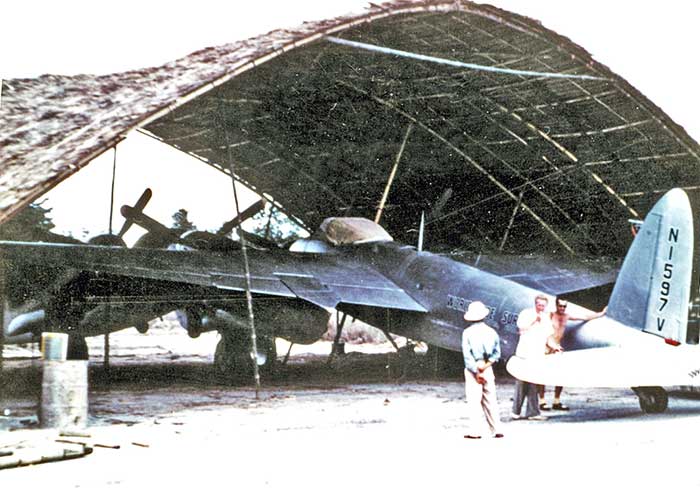
Photo by Ken Slack of Aero Service Corp, via Norm Malayney
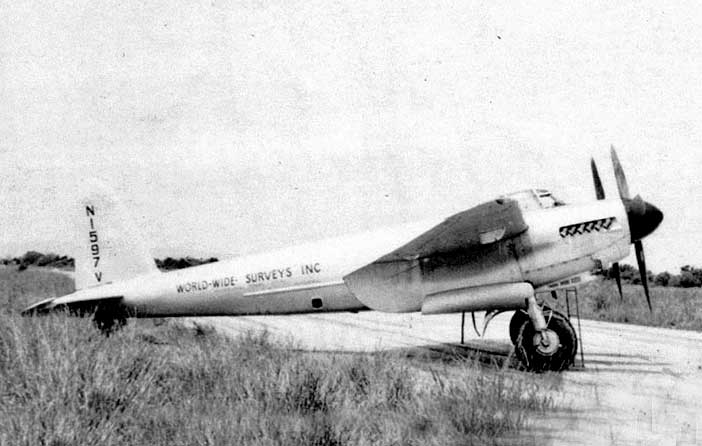
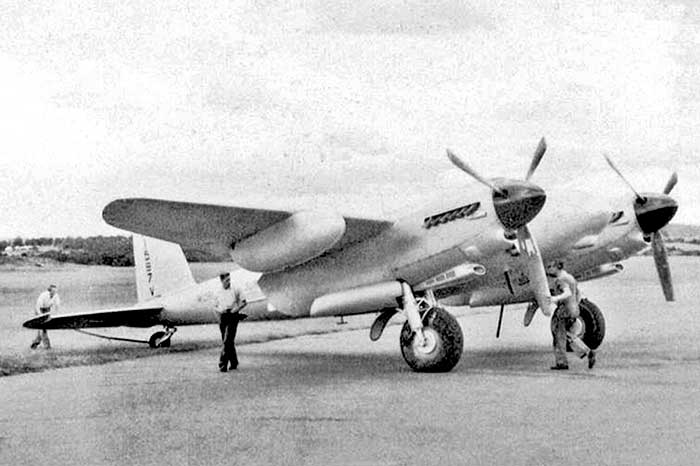
Photo by Morry Lawrence via Doug Morrison
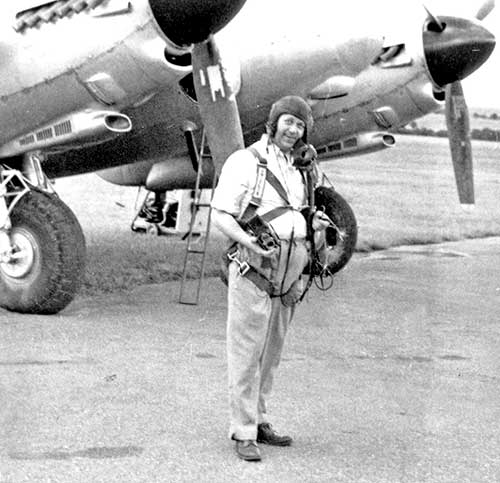
a test flight in N1957V. Photo by Morry Lawrence via Doug Morrison
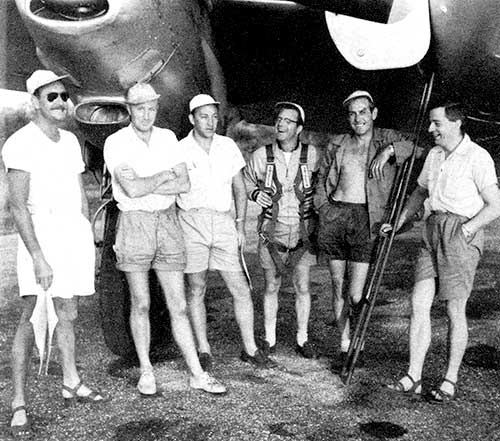
Photo: Aero Service Corp via Doug Morrison

Photo: Aero Service Corp via Doug Morrison
The end of World-Wide Surveys resulted in Morry Lawrence and his chief engineer Noel Notley going into partnership during 1957 to establish a new business to retain the Camden hangar and facilities: Lawrence Engineering and Sales Pty Ltd with an associate Lawrence Engineering Services offerd a wide range of light aircraft aviation maintenance as well as sales of aircraft, engines and parts.
Refer DH.82 The LES Tiger Moths in this series.
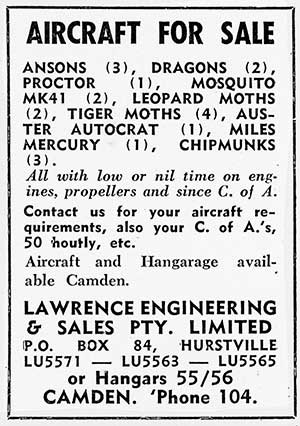 | 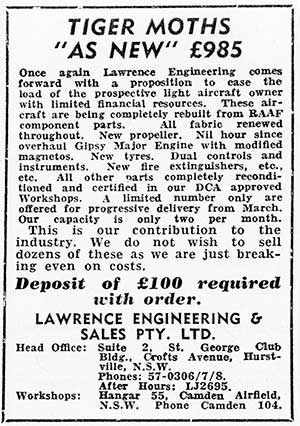 |
Meanwhile Morry Lawrence had continued his agency relationship with Aero Service Corp, Philadelphia through his company In 1960 in anticipation of a boom in large scale geophysical & photogrammetric survey for minerals and oil across Australia, Aero Service Corp established an Australian associate Aero Service Ltd, Sydney. Lawrence was General Manager and his company M.J.Lawrence Holdings Pty Ltd, Sydney held the all-important Australian Department of Civil Aviation Airwork Licence. In July 1960 Aero Service Corp (USA) sent a Piper PA-23 Apache 160 N3182P to Australia to commence a series of surveys. The Apache was equipped with magnetometer sensor in a tail boom and was serviced at Camden by Noel Notley to become VH-MJL and commence six years of Australian work. It was followed by Cessna 180 VH-MZR, DC-3 N9032H (VH-MJR), Aero Commanders N6108Y (VH-MJJ) and N830Q, all carrying out photographic or mineral/oil survey work by Aero Service Ltd. Lawrence set up a processing facility at Rocky Point Road, Ramsgate, Sydney with full geophysical data processing, photography labs, photogrammetric facilities and a staff of 30 when it ceased in 1965. At that time Aero Service Ltd dispensed with Lawrence's services and a new Sydney survey operator Gale Air Pty Ltd (Gale Moulten) took over Australian work.
Morry Lawrence left aviation to move on to other business ventures including real estate, retail stores and sales agencies.
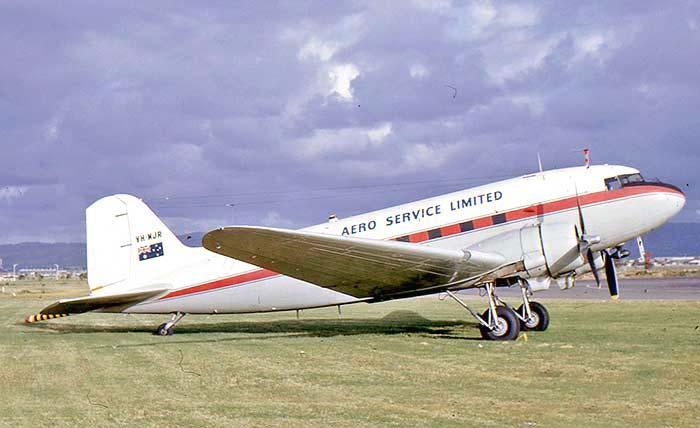
Seen at Adelaide in December 1964 while conducting a two week magnetometer survey of St Vincents Gulf.
Photo by John M. Smith, courtesy SA Aviation Museum
|
*
*
*
*
*
*
*
* |
The majority of RAAF Mosquito disposals were to scrap metal merchants
at "aircraft remnants"low prices, most then being burnt to easily
retrieve the engines and metal fittings. A few were resold to farmers from the main storage base RAAF Tocumwal NSW.
Following the 1953 retirement of the last RAAF Mosquitos of No.87 (Survey) Squadron, all Mosquito stocks were handed over to the Deparment of Supply for disposal action. During 1954 Mosquitos began appearing in DoS auction sales lists inviting bids. These were Mk.16 and Mk.41 photo recce aircraft generally still in good condition. Those not sold remained in RAAF storage in the open weather to be later re-advertised in much poorer condition as late as 1958.
Following the 1953 retirement of the last RAAF Mosquitos of No.87 (Survey) Squadron, all Mosquito stocks were handed over to the Deparment of Supply for disposal action. During 1954 Mosquitos began appearing in DoS auction sales lists inviting bids. These were Mk.16 and Mk.41 photo recce aircraft generally still in good condition. Those not sold remained in RAAF storage in the open weather to be later re-advertised in much poorer condition as late as 1958.
Founded by wartime pilot Claire Morrill Waterbury. When WWII broke out in Europe, Waterbury took civilian pilot training in USA and was one of the first American volunteers to join RAF. He flew Wellingtons, Fortress and Hudsons before transferring to US Navy in December 1942 to fly TBF Avengers and PBY-5 Catalinas. After his time with AEC, Waterbury returned to Britain and by 1957 was London representative for Philippine Airlines, a role he held for 22 years. He remained in Britain where he died in June 2017 aged 97.
(This biography courtesy Canadian researcher Robert M. Stitt)
During 1953 AEC president Clair Waterbury had visited NZ and Australia to purchase Mosquitos: see A52-313 above.
The following year AEC submitted a bid for another three RAAF Mosquitos, resulting in a lengthy dispute:
RAAF Mosquito Mk.16s A52-602, -608, -610
- In May 1954 AEC was the successful tenderer to the Department of Supply for these three Mosquitos plus spare tyres, radiators and Merlin 31 engines. The aircraft were stored at RAAF No.3 Aircraft Depot Amberley's detachment at Archerfield Airport, Brisbane, Queensland. Terms of sale required payment within 30 days and collection within 60 days.
- No reply from AEC to three letters from Dept of Supply regarding final payment and collection of the aircraft
- 21 February 1955 letter from Dept of Supply to AEC stated that unless monies owed are paid within 21 days the goods will be resold and the deposit would be forfeited. No reply.
- 10 May 1955 the 3 Mosquitos plus parts were resold to Wilmore Aviation Co, Sydney for a total of £135 from 3AD Detachment Archerfield Airport and broken up for parts
- 10 June 1955 letter from Dept of Supply to AEC advising of the resale and confirming that their deposit was forfeited
However.....
- 14 January 1955 letter from Bob Bean to Officer Commanding, RAAF Archerfield advising that he had purchased the three AEC Mosquitos and requested advice of what storage charges were outstanding
- 27 January 1955 letter OC Archerfield to Bean advising no storage fees were being charged and it was anticipated that no demand would be made when he collected the aircraft
- RAAF Archerfield did not advise Department of Supply of this correspondence with Bean Aircraft Inc
- 6 December 1956 letter Bob Bean to Department of Supply Director of Contracts enquiring on the status of his three Mosquitos
- 1 February 1957 letter from Dept of Supply to Bean setting out the sales record and advising that the aircraft had been resold
- 25 March 1957 letter from Bob Bean Aircraft Inc to Dept of Supply demanding compensation, based on their correspondence with RAAF Archerfield confirming their ownership
- 17 April 1957 Dept of Supply refered the file to the Australian Crown Solicitor for a legal opinion: response states "Mr. Bean appears to have acted in good faith. An oversight was made by someone in the Commonwealth of Australia."
- 28 May 1957 letter from Dept of Supply to Bean offering to credit him with £135 (Aust) to be used as a deposit on any future tender he may lodge. In separate correspondence Bean asks if P&W R-1830 Twin Wasps were available but none at that time.
- 15 September 1957 Australian Crown Solicitor memo: "The Department of Supply Contract Board has been placed in a embarassing position because of the failure of the RAAF to advise it of correspondence received from Bob Bean Aircraft Inc that they had purchased the aircraft from Aviation Export Co Inc, the original purchaser."
- Department of Supply file ends.
- February 1956 Survair Pty Ltd was the successful bidder for Mosquitos offered by Dept of Supply.
- 25 March 1957 letter from Dept of Supply to Survair Pty Ltd: "Despite repeated requests you have not taken delivery of the aircraft. Storage costs to 30 March 1957 are £103. The Department of Air advises that it is not prepared to allow the aircraft to remain any longer on RAAF premises. Unless the storage fee is paid within 21 days, the aircraft will be resold." No reply
(The Dept of Supply file does not identify the aircraft involved, their location, or whether the sale was one or more aircraft)
One can summise that after bidding for the aircraft, the partners approached DCA with their plans, to learn that the Department would not allow civil operation of ex military combat types such as the Mosquito. The few that had flown were under foreign registration or on a special case dispensation. Nothing further heard of Survair Pty Ltd.
Wilmore's Mosquito purchases were as follows:
- May 1955 three Mosquito 16s A52-602, -608, -610 plus spare parts including tyres, radiators and Merlin 31 engines, for a total price £135. These were the three not collected after earlier sale to Aviation Export Co, Los Angeles (see preceeding AEC entry)
- March 1958 eight PR.41s A52-315, -316, -317, -318, -320, -321, -322, -323 stored at 3AD's Archerfield detachment. They were broken up for engines, instrumentation, tyres and other components.
- Prior to these purchases however, Wilmore had briefly owned Mosquito A52-600 offered for disposal in early 1954 at RAAF Ballarat Vic.
The twists and turns in the story of this aircraft's disposal are detailed in the following summary:
| Built by De Havilland Aircraft Co Ltd at Hatfield as part of order for 250 Mosquito Mk.XVI . Completed as a PR. XVI photo reconnaisance model with RAF serial NS631 | |
| Allotted to RAAF, shipped to Australia | |
| 25.11.44 | Taken on RAAF charge as A52-600. Received 2AD Richmond ex UK |
| 4.3.45 | Received 87 (PR) Squadron, Coomalie Creek NT ex 2AD |
| 23.3.45 | First operational PR sortie, to Timor and return |
| 11.8.45 | Last
wartime sortie over Kuching POW camp, Borneo. A52-600 had flown 21
missions over enemy territory over the Netherland East Indies and Borneo |
| 11.7.46 | Received Survey Flight ex 87 Sqn. Unit code "SU-A". Unit later renamed Survey Squadron |
| 9.7.47 | Allotted 3AD Storage Archerfield for storage |
| 16.7.47 | Previous allotment cancelled. Reallotted Air and Ground Radio School, Ballarat for instructional purposes |
| 28.7.47 | Received AGRS Ballarat ex Survey Flight |
| 22.10.47 | Approval to convert to Instructional Airframe No.4 |
| 3.4.52 | Held at AGRS with Merlin engines Instructional 82 & 83 installed |
| 4.12.53 | To be listed by Department of Supply for disposal |
| 2.54 | Dept
of Supply Disposal List No.1/54 included Mosquito A52-600 and Mustang
A68-39 both both described as instructional airframes located at RAAF
Ballarat |
| .54 | Both aircraft sold by Dept of Supply to Wilmore Aviation Services (Victoria) Pty Ltd |
| Dept of Supply file minute 19.10.54: "The
experience of this Department has been that instructional airframes
have little sales value and as a result public tenders were invited in
Melbourne and Sydney only. It was not surprising when only one tender
was received. This tender from Wilmore Aviation Services (Victoria) Pty
Ltd was £105 for the Mosquito and £206 for the Mustang. The Mustang was removed on 15 July 1954. When it was learnt by this Department that the aircraft was flown out of Ballarat Station, a further check with the Department of Air disclosed that although internal directions had been issued for these two aircraft to be reduced to instructional airframes by remobal of engines etc, the instructions were not implemented. Instead of our Department selling two airframes of little value, two complete aircraft were involved in this transaction." | |
| (Mustang
A68-39 was sold by Wilmore to Fawcett Aviation, Sydney and became
VH-BOY in 10.59 when DCA approved Fawcett to use ex RAAF Mustangs as
target tugs for military support operations) | |
| 10.54 | Mosquito
A52-600 is still at Ballarat, not yet collected. RAAF Ballarat
Commanding Officer has been informed that Wilmore had resold it to W.
F. Gordon, Strathmore Vic, a scrap metal dealer. |
| Removal
of A52-600 placed on hold while Dept of Supply seeks advice from
Australian Crown Solicitor. The Dept is concerned that complete
aircraft have been sold for prices below normal values. The legal opinion is that the sale of the Mosquito should be cancelled then offered again as an airframe only without engines, which could be listed aseparately. | |
| 15.11.54 | Wilmore
Aviation Services agrees to the cancellation of the Mosquito sale and
refund of £105, conditional on Wilmore retaining the Mustang. Dept of Supply agreed |
| A52-600 remained parked with Merlins installed in an AGRS hangar at Ballarat | |
| .57 | Offered for disposal in a Dept of Supply disposal list. Condition quoted as "Partly damaged" |
| 6.57 | Barrie
Colledge, a young Royal Victorian Aero Club flying enthusiast and his
friend Jeff Bennett, sent off for tender application forms for A52-600.
The pair arranged an inspection of the Mosquito and flew Aero Club
Chipmunk VH-RVZ from Moorabbin to Ballarat on Saturday 29 June 1957.
Barrie tells the story: "I taxied direct to the RAAF hangars where we were met by a RAAF representative. The hangar doors were pushed open and there in all its splendour stood A52-600 coded SU-A all over silver with blue and white roundels. First imoressions: the main tyres were deflated and there was a liberal coating of dust all over the upper surfaces and particularly the transparencies. The MerinsBut what was damaged? Unless it was structural, the only damage evident was a broken navigation light. had been inhibited and the interior was virtually instact, only some odd pieces of instrumentation having been removed." The partners submitted an offer, Barrie thinks £400 from memory, which was far more than they could afford. They just wanted to save the Mosquito by using it for airframe apprentice training at a location to be found. The tender documents required the successful tenderer to remove the aircraft within 10 days of of purchase - quotes to dismantle a Mosquito and load it suitable road transport proved prohibitively expensive. To their relief, they received no response from the Dept of Supply. |
| .57 | Acquired for £50 by Ernst H. Voullaire, Monak NSW.
The wings were sawn off at the fuselage to allow it to be transported
by road from Ballarat to his fruit orchard at Monak, near Mildura Vic. |
| After unloading at the Monak property, reassembling the aircraft proved too difficult, so it was left dismantled | |
| .67 | Discovered by a team from the Warbirds Aviation Museum
which proprietor Pearce Dunn was establishing at Mildura Airport.
Remains of RAAF Ansons, Mustangs and a V-S Kingfisher had been located
on farms in the Mildura district but the Mosquito was an unexpected bonus |
| Pearce Dunn negotiated with Mr.Voullaire to purchase the Mosquito "as is" | |
| 23.9.67 | Collected by Pearce Dunn for Warbirds Aviation Museum, Mildura Airport Vic Loaded on trucks and moved to Mildura Airport where stored dismantled in the one remaining wartime Bellman hangar, where Pearce was storing his aircraft |
| Warbirds
Aviation Museum set up at Mildura Airport on the foundations of the
buildings of the wartime RAAF station. Aircraft were moved into the
museum compound but the Mosquito remained in the hangar | |
| 82 | Pearce
Dunn rationalised his museum collection by selling certain aircraft to
raise funds for buildings and improvements. The Mosquito was offered
for sale |
| 9.83 | A52-600 was sold to Vincent Thomas, Alan Lane and Geoff Milne, Albury NSW This partnership of military aircraft enthusiasts had purchased incomplete P-51D Mustang A68-674 from Pearce Dunn the previous year and just acquired a CAC Wirraway A20-652 from Melbourne as restoration projects |
| Stored dismantled at Albury NSW | |
| .83 | Registration VH-JUX reserved, but little restoration of the airframe achieved |
| .87 | Traded to RAAF Museum, RAAF Point Cook Vic Transported from Albury to RAAF Laverton where RAAF Museum had a storage hangar. |
| .90 | Airfreighted from RAAF Laverton to RAAF Richmond by C-130. Restoration commenced on fuselage. Displayed ina hangar for a 1991 airshow |
| 31.3.98 | Transported from RAAF Richmond to RAAF Point Cook by C-130. Stored by RAAF Museum |
| 3.02 | Restoration commenced in RAAF Museum restoration hangar Point Cook |
| Restoration continues at Point Cook |
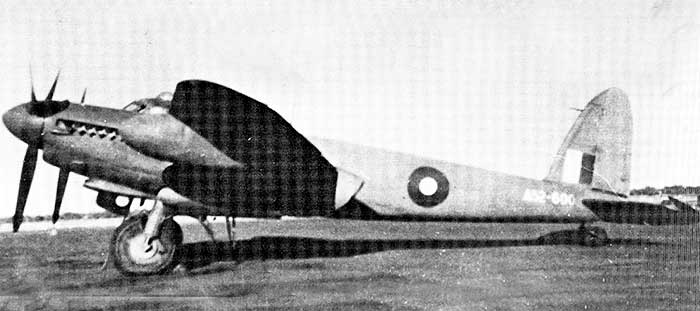


It was moved to Mildura Vic for his fledgling Warbirds Aviation Museum. Photo by Geoff Goodall
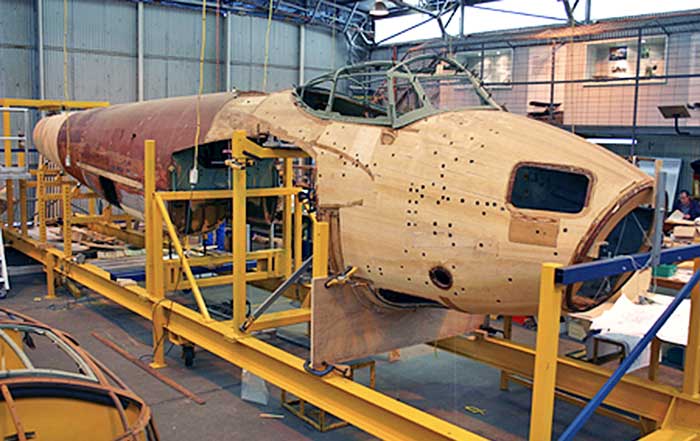
618 Sqn had been one of two squadrons formed specifically to drop Barnes Wallis' remarkable Highball "bouncing bombs". The other was 617 Squadron with Lancasters, which carried out the famous low-level Dam Busters raid on German dams. The Mosquito squadron was sent to Australia to work up in preparation to using Highball on Japanese targets. Four of these Mosquitos were lost in accidents in Australia.
RAAF Station Narromine in central NSW was selected as the Australian base for 618 Squadron's Mosquitos, where training got under way. The squadron's support aircraft were six Fairey Barracudas. However the planned British participation in the allied advance on Japan did not take place and 618 Squadron was disbanded in July 1945 and its personnel sailed for India. The Mosquitos were offered to the RAAF but because of operational differences to the Mosquitos then in RAAF service (Australian and British built) the offer was declined and they were left behind, lined up Narromine. The Barracudas were shipped back to Britain and the 125 stored Highball bombs were detonated in controlled explosions.
The little-known story of 618 Squadron's time in Australia is told in detail in David Vincent's excellent book Mosquito Monograph.
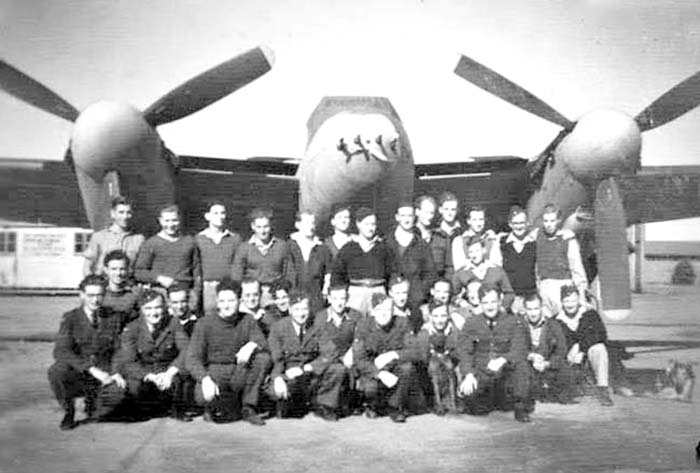
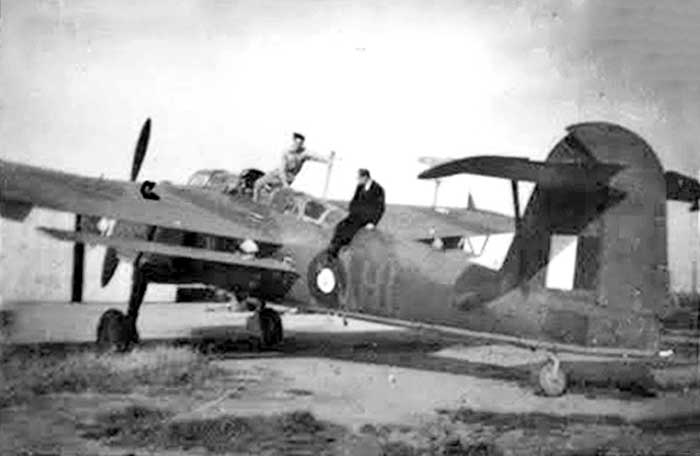

Note the 4 bladed propellers on the aircraft in the rear row. Photo via Derek Macphail
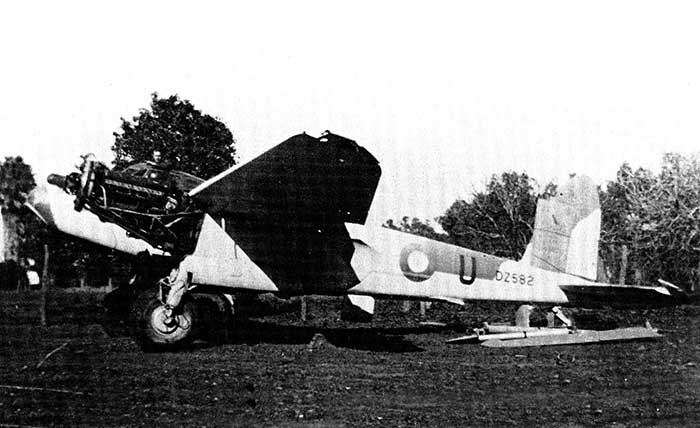
Narromine soon after he towed it home in 1947. Photo: Pearce Dunn collection
Three of the 618 Squadron disposals have been identified:
- DZ542 Mosquito B.IV: The weathered remains on a farm in the Narromine district were collected circa 1988 and sent to New Zealand to Mosquito enthusiast Glynn Powell. He traded as Mosquito Aircraft Restoration Ltd, Auckland and had devised a commercial method to rebuild the complex Mosquito airframe wooden structures. Glynn teamed up with Avspecs at Auckland-Ardmore Airport for a series of airworthy restorations of Mosquitos for North American warbird operators. The restored fuselage of DZ542 was moved to Ardmore in 2015 as the basis of an airworthy restoration funded by The Mosquito Pathfinder Trust in UK, however for the MPT project was replaced by the fuselage of a RNZAF Mosquito T.Mk.43 NZ2308.
- DZ625 Mosquito B.IV: In March 1948 Mr. Frank Hatter, Tullamore NSW towed DZ625 from Narromine to his property. He later moved the aircraft to another farming property near Canowindra NSW, and stored surviving substantial sections in a shed at Forbes NSW. They were collected in the 1990s by the Australian War Memorial to provide parts for their restoration of VH-WAD to display standard.
- HR621 Mosquito FB.VI: Found in 1968 on the farm of Mr. M.Powell, Tomingley NSW by members of the Camden Museum of Aviation. It was in the best condition of Mosquitos located and Mr. Powell agreed to donate the aircraft to the museum. During October 1968 it was moved by road 450 km to Sydney. Parts from 7 other Mosquitos were collected for the museum's restoration project. HR621's cockpit section was stored in Alan Thomas' home garage in the Sydney suburb of Kogarah where he commenced working on its restoration.
The Camden Museum of Aviation was started in 1963 by experienced Sydney aircraft engineer Harold Thomas, who leased a hangar at Camden Airport to house his growing collection of aeroplanes. Later the collection was moved to nearby Narellan to a newly-built display hangar on private property where Harold and his son Alan continued to maintain their private collection. Alan has stated that the project even includes some parts salvaged from the two World-Wide Surveys Mosquitos burnt at Camden.
During the 1970s all Mosquito components were moved to the Narellan museum hangar where reassembly commenced. It is a long-term project, but Alan Thomas and the volunteers at the Camden Museum of Aviation are congratulated on what they have achieved. Unfortunately mounting costs have forced the closure of the museum to the public.

Photo taken in 2014 by Ian McDonell
In a 10 day operation, the sheep were loaded on a float, a few at a time, then pulled by men in a row boat across 4 miles of flood waters to land where thery were transferred to a horse-pulled dray to another stretch of water. Here they were loaded on the second raft and pulled to a road where they were loaded on livestock trucks. Falkiner had hired an Australian National Airways (ANA) DC-3 freighter to collect the rams from the Haddon Rig airstrip but the ground was too boggy - so the plan was changed for the DC-3 to land at Dubbo Aerodrome. The sheep were sent to Dubbo in two groups, 37 by train from Warren to Dubbo, the remainder by trucks via a circuitous route to avoid flooded roads. The ANA DC-3 flew them to Brisbane in two trips, and the Haddon Rig rams sold for record prices at the Brisbane sales.
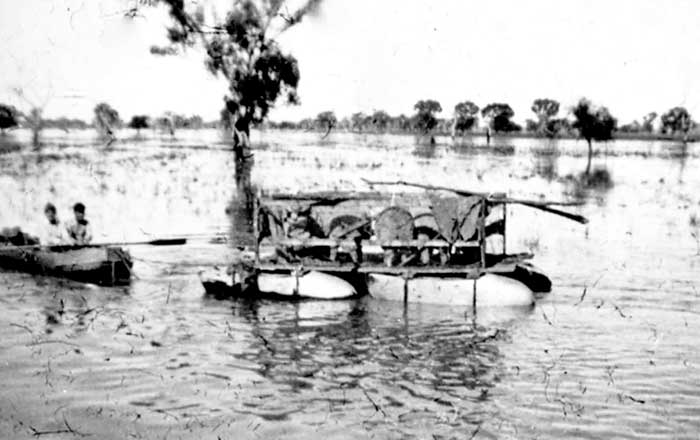
This photo was taken by Haddon Rig stockman Alex McDonald in July 1950. Courtesy Roger McDonald
This splendid photograph taken by RAAF wartime photographer John T. Harrison illustrates Mosquito underwing wing drop tanks:

"Break to port"- RAAF
No.1 Squadron Mosquito FB.VIs at RAAF Amberley Qld on 17 July
1945, prior to
deployment to Borneo during the final days of the Pacific war. Taken from a RAAF B-25 Mitchell
American military aircraft dealer Robert F. Bean (see Part 3 above) purchased six RNZAF Mosquitos in 1953 in the name of his company Aircraft Sales Inc, Los Angeles California. They were civil registered ZK-BCT to ZK-BCX and two were delivered to USA by the same ferry crew as N4928V from Sydney (see part 2 above). At that stage the New Zealand Government blocked further departures, citing concerns that they could be destined for clandestine military use overseas. Here's one that reached California:
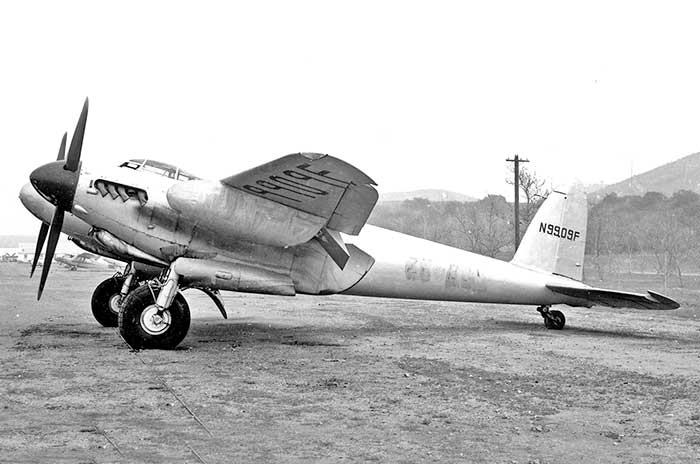
Mosquito FB.VI N9909F (ex NZ2384) was photographed by Eddie Coates in 1958 at Pacoima, California,
where it was serviced by Volitan Inc for owner California Air Charter. Previous NZ registration ZK-BCV
is readable on the fuselage. Volitan later produced the Volpar range of Beech 18 modifications.
where it was serviced by Volitan Inc for owner California Air Charter. Previous NZ registration ZK-BCV
is readable on the fuselage. Volitan later produced the Volpar range of Beech 18 modifications.
This story could not have been compiled without the assistance of Doug Morrison in Sydney, who willingly shared his extensive research into early magnetometer aerial survey operations in Australia. Thank you Doug.
- Australian Civil Aircraft Register, Department of Civil Aviation, Melbourne
- DCA file VH-WWS/N1596V, National Archives of Australia, Sydney
- DCA file VH-WAD, National Archives of Australia, Perth
- Log book of Sepal air survey camera operator Kevin Pavlich, courtesy Ron Cuskelly
- National Library of Australia: Trove newspaper search site
- Airforce Association (WA) file for VH-WAD
- US Civil Aircraft Register, FAA site: http://registry.faa.gov/aircraftinquiry/NNum_Inquiry.aspx
- Adastra Aerial Surveys website: http://www.adastron.com/adastra/aircraft/misc/mosquito.htm
- Mosquito Monograph - A history of Mosquitoes in Australia and RAAF Operations, David Vincent, self-published Adelaide 1982
- The Last Working Aussie Mossies, Doug Morrison, Flightpath magazine, Melbourne, August-October 2000
- California Mosquitoes, Norman Malayney, American Aviation Historical Society Journal, Spring 2002
- N1596V and N1597V The Last of the Aussie Mossies, Doug Morrison, American Aviation Historical Society Journal, Fall 2010'
- De Havilland Aircraft Since 1919, A. J. Jackson, Putnam, London 1978
- British Military Aircraft Serials 1911-1979, Bruce Robertson, Patrick Stephens, Cambridge 1979
- Jimmy Woods Flying Pioneer, Julie Lewis, Fremantle Arts Centre Press 1989
- Information from Ron Cuskelly, Roger McDonald, Chris O'Neill, Derek Macphail, Neville Parnell, Ian McDonell